Special to Transport Topics
Automated Trucking Levels Up
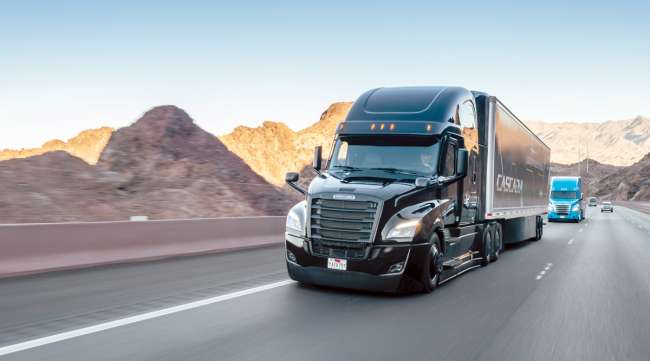
[Stay on top of transportation news: Get TTNews in your inbox.]
After several years of fanfare and debate over when and how self-driving commercial vehicles would reach the market, early forms of this technology are beginning to become an option in new trucks.
The first trucks equipped with automated steering features soon will enter production, advancing the trucking industry to a new stage of driver-assistance technology.
The introduction of automatic steering correction and lane centering, combined with adaptive cruise control and collision mitigation capabilities that already are available, will mark the beginning of Level 2 automated driving in mass-produced trucks.
Level 2 automation, as defined by SAE International, means the system can automate acceleration, braking and lateral movement under certain conditions, but still requires the driver to remain fully engaged at all times.
In the near future, Daimler Trucks North America will provide active steering as an option in Freightliner Cascadia models equipped with its Detroit Assurance 5.0 suite of camera- and radar-based safety technology.
WANT MORE NEWS? Listen to today's Daily Briefing
That enhancement will make the Cascadia “the first SAE Level 2 truck in series production in North America,” said Suman Narayanan, DTNA’s director of autonomous driving engineering.
DTNA executives recently said the company’s forthcoming automated steering features, known as Active Lane Assist, will become broadly available in the first quarter of 2020.
Active Lane Assist will include lane keep assist, which automatically keeps the truck centered in its lane while adaptive cruise control is engaged, and lane departure production, which steers the truck back into its lane if its starts to drift without a turn signal.
DTNA developed adaptive power steering and lane-keeping assist capabilities with Bosch, Narayanan said. The system relies on a forward-facing camera to monitor the vehicle’s position with respect to the detected lanes. The adaptive power steering then applies microsteering movements with the help of the “servomotor” that is part of the steering gear, Narayanan said.
The first wave of active steering capabilities could help pave the way for other automated driving features.
“Adaptive power steering will continue to evolve to expand on its capabilities to fulfill growing driver-assistance system features in the near term,” Narayanan said.
Previously, steering assistance in commercial trucks has been limited to lane-departure warnings and blind-spot monitoring.
The main hallmark of Level 2 is “both longitudinal and lateral assist,” said Ananda Pandy, technical specialist for advanced driver-assist systems and autonomy at ZF Group.
“The first [pre-Level 2] systems were just doing adaptive cruise control,” while emerging Level 2 trucks will offer active acceleration and deceleration while steering the truck for the driver, Pandy said.
Volvo Trucks also is actively engaged in developing Level 2-enabled trucks, said Anna Wrige Berling, traffic and product safety director for the Sweden-based truck manufacturer.
She did not disclose a timeline for commercial introduction of the technology, but said Volvo’s Level 2 trucks will emphasize driver benefits as opposed to just adding technology for technology’s sake.
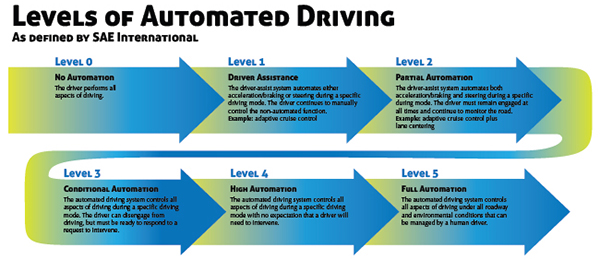
“The steering, the braking and the acceleration must always be able to add to driver comfort and safety in some way for it actually to be beneficial,” Berling said.
Navistar, which manufactures International brand trucks in North America, will offer Level 2 driving with automated lane-centering capabilities in its trucks “within the next 12 to 14 months,” said Darren Gosbee, the truck maker’s vice president of advanced engineering.
“We will say our [automated trucks] will be a continuous refinement of the Level 2 functionality,” Gosbee said. “And as the technology improves, on the sensor side, we will be able to continually enhance and push the levels of functionality.”
Among the new entrants in the commercial truck business, Tesla previously announced plans to offer automatic lane-keeping and lane-departure warnings with its all-electric Class 8 Tesla Semi.
Pronto, a self-driving startup, also has begun the early stages of commercializing its own Level 2 automated driving system for trucks, initially as an aftermarket product.
Suppliers’ Role in Level 2
Major industry suppliers will continue to play a key role in the design and rollout of Level 2 automated driving systems for trucks.
These suppliers have been continually developing combinations of steering control and sensors, such as cameras and radar, that convey real-time data to the electronically controlled steering system.
Navistar, for example, is “working very closely” with its ADAS supplier partners, Gosbee said.
“The different components suppliers are really the focus for Navistar when we talk about lane-keeping assist,” Gosbee said. “The integrator role is most definitely what we are performing.”
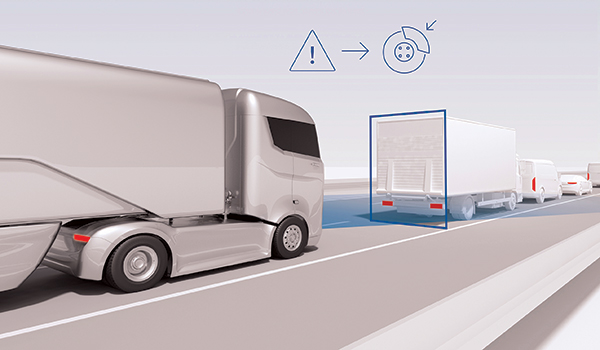
Automated steering will integrate with existing safety features such as collision mitigation and automatic emergency braking. (Bosch)
Bosch continues to refine its embedded cameras and automated lane-keeping assistance capabilities to support its OEM customers, said Jason Roycht, vice president and regional business leader for commercial vehicle and off-road at Bosch North America.
“During the next three years, you’ll start to see more OEMs using electric steering and adding that as part of driver assistance solutions, such as lane-keeping assistance and automated steering,” Roycht said.
While these technologies have existed for many years, integrating them in trucks in a safe and robust way has been “part of the engineering challenge,” he said.
“Underneath, we have the building blocks of actuation and the building blocks of the sensors, and then you have the technical functionality of how you do that in a safe way,” Roycht said. “The building blocks for a Level 2 system also represent the same concept for fully automated or Level 4,” in which the truck could drive itself over designated routes without input or monitoring required by the driver.
Suppliers also are developing new sensor arrays as they test combinations of radar, camera and lidar, a powerful yet expensive sensor option.
These sensors detect and monitor road conditions, lane and sign markings, blind spots and ultimately anything that may affect how a truck is driven.
Lidar sensors, which use sweeping lasers that can render 3D scans, remain in development, but generally are seen as supporting more-advanced Level 4 driving.
ZF, which owns a stake in lidar-maker Ibeo Automotive Systems through its subsidiary Zukunft Ventures, continues to look at lidar and explore options for its use.
“The idea is being able to put this sensor constellation together that gives you the redundancy that you need for safety-critical operations and is complementary enough that it gives you sort of a rich view of the environment,” said Dan Williams, director of ADAS and autonomy for commercial vehicles at ZF.
“Specifically about Level 2 systems, each sensor needs to be considered on its own and for the particular application that it’s intended for, but it’s possible to have Level 2 systems without lidar,” he said.
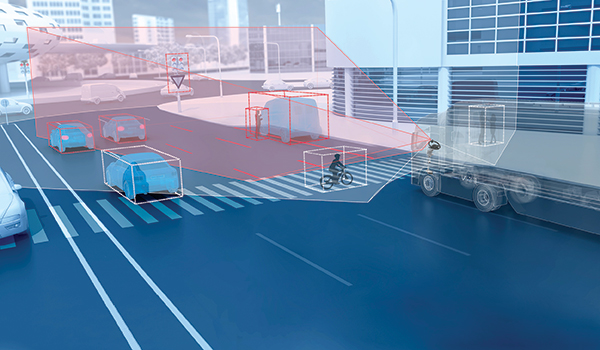
ZF's Dual-cam two-lens camera tracks nearby vehicles, pedestrians, road markings and traffic signs to support advanced driver-assist systems. (ZF Group)
The real question, Williams said, is whether it will be possible to reach higher levels of automation without lidar.
In June, ZF introduced its Dual-cam two-lens camera specifically designed for the commercial truck market for use with other ZF ADAS technologies as part of its OnTrax lane-keep assist technology.
Part of ZF’s S-Cam4 family of automotive grade cameras, the Dual-cam was developed in part to support self-driving capabilities with traffic sign recognition, lane-keeping assist and lane centering, and object and pedestrian monitoring.
When queried about upcoming Level 2 designs, a ZF spokesman told Transport Topics that the company is “awaiting the announcement of a launch with a major OEM in 2020.”
Wabco, which ZF agreed earlier this year to purchase for $7 billion, has announced its own lane-keeping assist system, OnLaneAssist, that relies largely on a forward-looking camera for active lane centering.
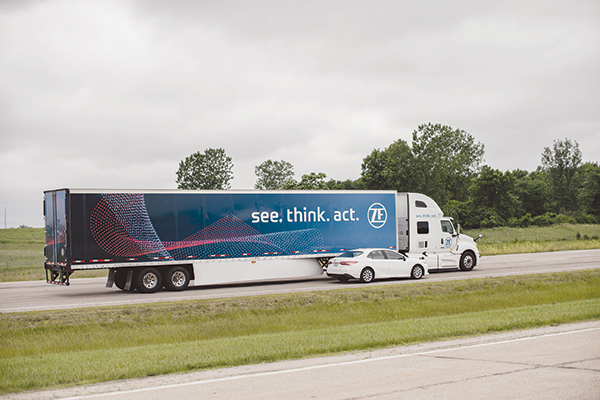
ZF demonstrates its OnTraX lane-keeping and lane-change assistance features on a test track at the Transportation Research Center in Ohio (ZF Group)
Commercial Viability
Despite the potential safety and driver-comfort benefits that Level 2-equipped trucks could offer, the return on investment for fleet owners remains difficult to quantify as the first wave of automated steering features enter the market, some industry observers said. Features such as lane-keeping assist and automated braking have been offered in luxury passenger cars for years, and are increasingly available in a broader range of car makes.
However, the business case for Level 2 automated driving in commercial trucks will need to prove itself in the market.
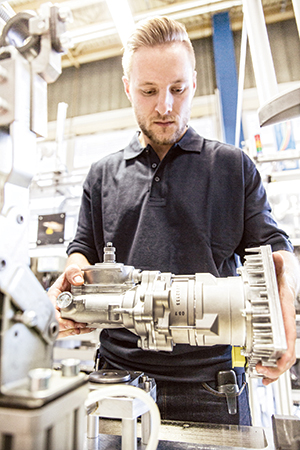
Bosch's Servotwin electro-hydraulic steering system supports active steering features such as lane-keeping assist. (Bosch)
“The technology is mature for offering Level 2 in Class 8 trucks, and I expect the truck OEMs are evaluating market readiness and timing for taking the leap to Level 2,” said industry analyst Richard Bishop, president of Bishop Consulting.
“Regulations allow it, but the [return on investment] is mushy,” he said. “Still, the convenience and stress reduction offered to drivers by a Level 2 system certainly can be important for driver recruiting and retention, and a less-stressed driver is a safer driver.”
Indeed, while Level 2 capabilities are poised to become increasingly available in commercial trucks in the short term, the pace of adoption largely will remain under evaluation, Bosch’s Roycht said.
“We’re going to have some of those features now, but how they will be marketed or how they will be accepted still needs to be figured out,” he said.
In the long term, truck manufacturers and motor carriers will need to ensure drivers do not overly rely on the automated driving features in Level 2 trucks, Volvo Trucks’ Berling said.
“It would be very important when we introduce such systems that we also effectively communicate in order to make the drivers fully understand the capabilities and the limitations of these systems so that they will not always use them,” Berling said. “I think it needs to offer the comfort for the drivers, but also, of course, the safety of it. The challenge is we need to make sure that the systems are used in the right way.” ³



